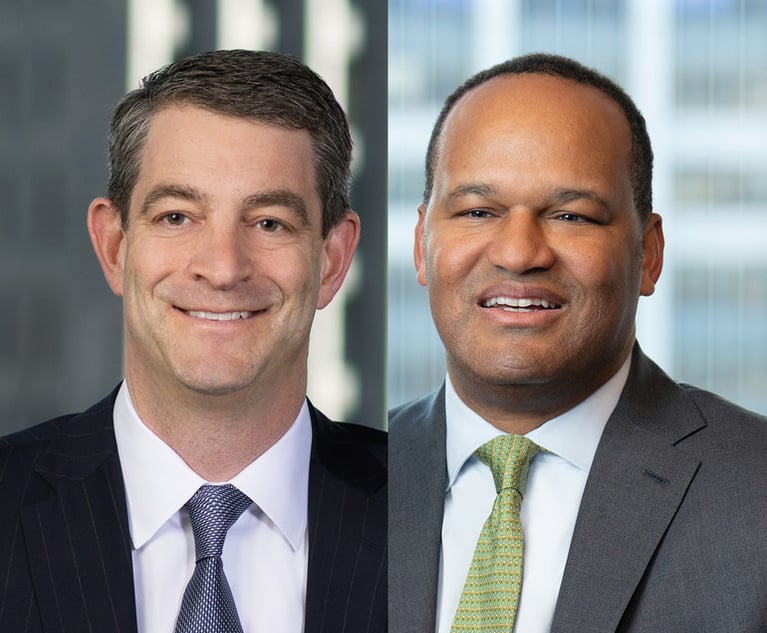More Mergers–and Merger Whispers–Keep Firms on Their Toes
Legal consultants say the number of firms engaged in undisclosed merger negotiations is on the rise along with the volume of announced deals, making early intelligence about potential mergers an especially hot commodity.
October 17, 2017 at 06:35 PM
31 minute read

Few observers expect law firm mergers to stop dominating legal industry headlines anytime soon. The volume of announced deals is poised to break records this year, and legal consultants say the number of firms engaged in undisclosed negotiations is also on the rise—making early intelligence about potential mergers an especially hot commodity.
Law firm mergers hit their 12-month peak in 2015, with 91 deals. The next year, that figure dropped to 85. But this year is easily on pace to surpass the record, with Altman Weil principal Eric Seeger predicting the number could hit 100 for 2017.
Berwin Leighton Paiser, a big U.K. firm that discussed a combination with Greenberg Traurig last year, is now mulling a potential union with Bryan Cave. The tentative deal, which both firms acknowledged in a joint statement on Monday, would create a combined 1,500-lawyer firm with 32 offices in 12 countries around the world. Total combined gross revenue would approach the $1 billion mark.
Earlier this month, sources told ALM that Andrews Kurth Kenyon and Hunton & Williams were engaged in merger talks. Smaller firms in markets across the country have been busily combining all year. Philadelphia alone saw a string of major deals last month, with Cozen O'Connor acquiring a real estate boutique in California, Ballard Spahr expanding into the Midwest, and Saul Ewing merging with Chicago-based Arnstein & Lehr.
Then, of course, there are all the potential deals that are still secret, with just a few partners privy to the negotiations.
Janet Stanton and Bruce MacEwen of Adam Smith Esq. in New York, along with Kent Zimmermann of Zeughauser Group, each said there's been an uptick lately in behind-the-scenes merger activity.
“There's deals happening,” Stanton said, echoing the sentiments of the other two.
Given that firms work so hard to keep early-stage talks quiet, Stanton noted that partner defections can be one predictor of ongoing or imminent merger talks.
“That is a really obvious thing to look at, because the people who are left behind are less and less mobile,” said Stanton.
In June, four months before The American Lawyer first reported the Andrews Kurth and Hunton & Williams talks, Shearman & Sterling announced that it had snapped up a five-partner team of antitrust lawyers from Hunton & Williams. (One of them, David Higbee, said the two events are “unrelated.”) Houston-based Andrews Kurth has also been hit with a series of partner defections this year. Most recently, one of the firm's key rainmaking partners, David Buck, co-chairman of the firm's corporate and securities practice, gave notice that he was leaving to go to Sidley Austin.
Several law firms have raided Andrews Kurth this year to expand their own Texas and energy practices. Greenberg Traurig in Dallas picked up four real estate lawyers in September. Jackson Walker took four partners from the firm this summer, while in February, King & Spalding took four corporate attorneys.
Of course, partner mobility is a hallmark of Big Law nowadays, and defections alone aren't a sure sign that a firm is on the merger market. “Some partners are more equal than others,” said MacEwen. “There are people who are sort of symbolic of the firm,” he noted, citing management committee departures as a signal that a firm may be casting about for a suitor.
MacEwen also points out that the rationale for merger discussions can sometimes boil down to “optics.” For a firm that appears to be flailing, engaging in merger talks at least means “it looks like you are doing something.” Plus, he acknowledged, “Bigger firms have more market awareness.”
But optics can only get firms so far. While plenty of deals are “well thought through,” said Stanton, “some of the mergers are just two drunks propping each other up.”

Few observers expect law firm mergers to stop dominating legal industry headlines anytime soon. The volume of announced deals is poised to break records this year, and legal consultants say the number of firms engaged in undisclosed negotiations is also on the rise—making early intelligence about potential mergers an especially hot commodity.
Law firm mergers hit their 12-month peak in 2015, with 91 deals. The next year, that figure dropped to 85. But this year is easily on pace to surpass the record, with Altman Weil principal Eric Seeger predicting the number could hit 100 for 2017.
Earlier this month, sources told ALM that
Then, of course, there are all the potential deals that are still secret, with just a few partners privy to the negotiations.
Janet Stanton and Bruce MacEwen of Adam Smith Esq. in
“There's deals happening,” Stanton said, echoing the sentiments of the other two.
Given that firms work so hard to keep early-stage talks quiet, Stanton noted that partner defections can be one predictor of ongoing or imminent merger talks.
“That is a really obvious thing to look at, because the people who are left behind are less and less mobile,” said Stanton.
In June, four months before The American Lawyer first reported the
Several law firms have raided
Of course, partner mobility is a hallmark of Big Law nowadays, and defections alone aren't a sure sign that a firm is on the merger market. “Some partners are more equal than others,” said MacEwen. “There are people who are sort of symbolic of the firm,” he noted, citing management committee departures as a signal that a firm may be casting about for a suitor.
MacEwen also points out that the rationale for merger discussions can sometimes boil down to “optics.” For a firm that appears to be flailing, engaging in merger talks at least means “it looks like you are doing something.” Plus, he acknowledged, “Bigger firms have more market awareness.”
But optics can only get firms so far. While plenty of deals are “well thought through,” said Stanton, “some of the mergers are just two drunks propping each other up.”
This content has been archived. It is available through our partners, LexisNexis® and Bloomberg Law.
To view this content, please continue to their sites.
Not a Lexis Subscriber?
Subscribe Now
Not a Bloomberg Law Subscriber?
Subscribe Now
NOT FOR REPRINT
© 2025 ALM Global, LLC, All Rights Reserved. Request academic re-use from www.copyright.com. All other uses, submit a request to [email protected]. For more information visit Asset & Logo Licensing.
You Might Like
View All

Latham's Lateral Hiring Picks Up Steam, With Firm Adding Simpson Practice Head, Private Equity GC
3 minute read

Eight Years On, A&O Shearman’s Fuse Legal Tech Incubator Is Still Evolving
4 minute readTrending Stories
Who Got The Work
J. Brugh Lower of Gibbons has entered an appearance for industrial equipment supplier Devco Corporation in a pending trademark infringement lawsuit. The suit, accusing the defendant of selling knock-off Graco products, was filed Dec. 18 in New Jersey District Court by Rivkin Radler on behalf of Graco Inc. and Graco Minnesota. The case, assigned to U.S. District Judge Zahid N. Quraishi, is 3:24-cv-11294, Graco Inc. et al v. Devco Corporation.
Who Got The Work
Rebecca Maller-Stein and Kent A. Yalowitz of Arnold & Porter Kaye Scholer have entered their appearances for Hanaco Venture Capital and its executives, Lior Prosor and David Frankel, in a pending securities lawsuit. The action, filed on Dec. 24 in New York Southern District Court by Zell, Aron & Co. on behalf of Goldeneye Advisors, accuses the defendants of negligently and fraudulently managing the plaintiff's $1 million investment. The case, assigned to U.S. District Judge Vernon S. Broderick, is 1:24-cv-09918, Goldeneye Advisors, LLC v. Hanaco Venture Capital, Ltd. et al.
Who Got The Work
Attorneys from A&O Shearman has stepped in as defense counsel for Toronto-Dominion Bank and other defendants in a pending securities class action. The suit, filed Dec. 11 in New York Southern District Court by Bleichmar Fonti & Auld, accuses the defendants of concealing the bank's 'pervasive' deficiencies in regards to its compliance with the Bank Secrecy Act and the quality of its anti-money laundering controls. The case, assigned to U.S. District Judge Arun Subramanian, is 1:24-cv-09445, Gonzalez v. The Toronto-Dominion Bank et al.
Who Got The Work
Crown Castle International, a Pennsylvania company providing shared communications infrastructure, has turned to Luke D. Wolf of Gordon Rees Scully Mansukhani to fend off a pending breach-of-contract lawsuit. The court action, filed Nov. 25 in Michigan Eastern District Court by Hooper Hathaway PC on behalf of The Town Residences LLC, accuses Crown Castle of failing to transfer approximately $30,000 in utility payments from T-Mobile in breach of a roof-top lease and assignment agreement. The case, assigned to U.S. District Judge Susan K. Declercq, is 2:24-cv-13131, The Town Residences LLC v. T-Mobile US, Inc. et al.
Who Got The Work
Wilfred P. Coronato and Daniel M. Schwartz of McCarter & English have stepped in as defense counsel to Electrolux Home Products Inc. in a pending product liability lawsuit. The court action, filed Nov. 26 in New York Eastern District Court by Poulos Lopiccolo PC and Nagel Rice LLP on behalf of David Stern, alleges that the defendant's refrigerators’ drawers and shelving repeatedly break and fall apart within months after purchase. The case, assigned to U.S. District Judge Joan M. Azrack, is 2:24-cv-08204, Stern v. Electrolux Home Products, Inc.
Featured Firms
Law Offices of Gary Martin Hays & Associates, P.C.
(470) 294-1674
Law Offices of Mark E. Salomone
(857) 444-6468
Smith & Hassler
(713) 739-1250










